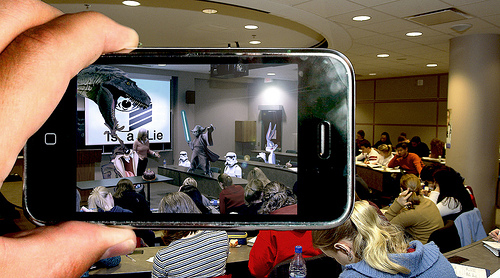For those of us with even a passing interest in technology, it seems that augmented reality has been the ‘next big thing’ for a while now. Technologies have been born and become obsolete in the time we’ve been waiting for AR to really take off.
With the proliferation of smartphones, a burgeoning tablet market, and quicker mobile surfing, it seems everything is finally coming together for augmented reality. A recent survey revealed that AR is regarded as one of the most exciting pieces of technology to happen to the industry. When quizzed on what technology marketers expect to change the way they do business AR sat comfortably in the top five and Visiongain claims that 25% of mobile apps will feature augmented reality in 2012.
Tesco and Lynx have been very successful adopters. Tesco used AR technology to add extra layers of digital content and interactivity to a series of printed ads in the Daily Mail – the additional context to the ad linked users to Tesco’s mobile website, deals and offered access to daily recipes. Meanwhile, Lynx proved successful in linking AR with social media with its ‘Angel Ambush’ campaign. The campaign went viral and has been viewed on YouTube over 1.2 million times to date.
As a business which deals with brands across multiple channels we’re always looking for ways to bring print and technology together in a more engaging and innovative way, and AR is shaping up to be the next driver in this area. Print remains a highly effective and valued channel for consumer engagement, but as AR edges towards its tipping point it can help to push DM into the future.
One of the reasons the technology should excite marketers is because of its potential in driving frictionless engagement. Through the use of AR, brands are able to interact with the customer easily and almost immediately as all they have to do is click a few buttons to be captivated for a period of time. Augmented reality also provides marketers with the opportunity to create more powerful and relevant content as it brings static images to life, layers content on top of the user’s immediate surroundings and brings the brand into the consumer’s world. The ability to bring content to life in this way opens up all kinds of possibilities in terms of creativity and design, which in turn drives engagement and creates stand-out.
While this no doubt excites the creatives within our industry, AR can also be used to drive insight – augmented reality can actually make DM more measurable, as the technology enables targeted tracking. There’s no way of knowing whether or not somebody has read your mail out before disposing of it, but you can track activation of content and click-throughs.
Coming at it from a different angle, there’s also an argument to say that DM is equally important to AR. Augmented reality will only be successful when integrated seamlessly with other channels, and DM has a vital role to play in that. The two media complement each other perfectly.
We are still only scratching the surface of the potential that AR and the personalised experience it can offer. In the long term, the novelty and ‘wow’ factor of AR will wear off, and the brands that will triumph are those that will integrate the technology seamlessly into their communications, while offering tangible benefits to their consumers such as money savings and increased convenience.
Adoption of AR within the DM industry should be seen as a huge opportunity to prove to the naysayers that direct mail can be an engaging and innovative medium. The clue is in the name – AR is here to augment the user experience.
For too long, the widely held belief was that the growth of digital channels only served to replace their analogue equivalents. However, the only media that are likely to struggle are those that lose sight of the basic principles of marketing, and fail to deliver something of real value to the consumer. AR shouldn’t be dismissed as just a cool new gadget, we should all quickly start to understand the greater potential to convey the message, engage the customer instantly and measure the response.
The relationship between AR and direct marketing is no different, the more willing the industry is to embrace and use the technology, the greater the potential to deliver campaigns that truly ignite the consumer’s imagination.






